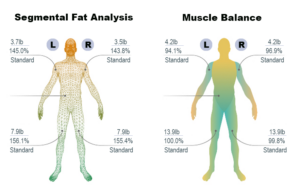Prioritizing Body Composition Over BMI: A Holistic Approach to Health

In primary care, the Body Mass Index (BMI) has long been used as a standard measure to assess if an individual is at a healthy weight relative to their height. Today however, more primary care clinicians rely less on BMI and look to body composition measurements for a more comprehensive view into a patient’s overall health. Body composition measurements offer insights into muscle mass, fat distribution, and other key factors that directly impact health. For those aiming to enhance their well-being, it’s essential to prioritize body composition over BMI. Here’s why.
The Limitations of BMI
BMI is a simple calculation based on a person’s height and weight, and it categorizes individuals into weight ranges like underweight, normal weight, overweight, or obese. However, this one-size-fits-all approach has limitations:
- It Ignores Muscle Mass: BMI doesn’t distinguish between fat and muscle. As a result, individuals with high muscle mass, such as athletes, can be classified as overweight or obese for their height despite being in excellent physical condition.
- It Overlooks Fat Distribution: BMI doesn’t indicate where fat is distributed in the body. Visceral fat around your belly is stored around vital organs and it poses greater health risks than subcutaneous fat, which is stored under the skin. Two people can have the same BMI but have very different fat distributions, which can affect their health in different ways.
- It Neglects Metabolic Health: Some individuals classified as overweight or obese by BMI standards may be metabolically healthy, with normal blood pressure, cholesterol, and glucose levels. Conversely, people with a normal BMI may still have underlying health conditions if they carry excess visceral fat, have poor muscle health, or have lifestyle factors like smoking or eating a high-fat diet.
The Importance of Body Composition

Body composition measurements offer a more detailed picture of health by assessing the proportions of fat, muscle, bone, and water in the body. This holistic view is crucial for understanding how your weight affects your health.
-
- Focus on Fat-to-Muscle Ratio: Body composition measures how much of your weight is made up of fat compared to lean muscle. A healthy balance between fat and muscle is critical for metabolic health, physical function, and disease prevention. Higher muscle mass can boost metabolism and help regulate blood sugar, reducing the risk of conditions like diabetes and heart disease.
- Identifying Dangerous Fat: Body composition assessments can help identify levels of visceral fat, which is a key risk factor for conditions like cardiovascular disease and type 2 diabetes. Reducing visceral fat can have significant health benefits – even if the number on the scale doesn’t change much.
- Tracking Health Improvements: Unlike BMI, which may not change even with healthy weight loss or muscle gain, body composition measurements allow for more precise tracking of health improvements. For example, as you gain muscle and lose fat, your body composition improves, even if your weight remains the same or even goes up. This can provide better motivation and guidance for individuals on a health journey.
The two most commonly used methods for measuring body composition are Bioelectrical Impedance Analysis (BIA) and Dual-Energy X-ray Absorptiometry (DXA). BIA sends a small electrical current through the body to estimate body fat, muscle, and water composition, offering a quick and affordable way to track changes over time, though its accuracy can vary with hydration and other factors. DXA, on the other hand, uses low-dose X-rays to provide highly accurate measurements of body fat, muscle, and bone density, making it ideal for precise assessments, though it’s more expensive and generally available only in specialized facilities.
Personalized Healthcare
One of the key benefits of focusing on body composition is the ability to tailor healthcare to each individual more effectively. For primary care providers, understanding a patient’s body composition helps guide more meaningful goals and more precisely targeted treatment plans. Whether the goal is weight management, preventing chronic disease, or improving overall fitness, understanding a patient’s body composition allows for interventions that go beyond superficial metrics.
For example, someone with a high BMI but a healthy body composition might need different advice than someone with a normal BMI but excess visceral fat. A personalized approach enhances the ability to address root health concerns and improves long-term health outcomes.
While BMI can be a useful starting point for assessing health risks, it’s essential to look beyond the number on the scale. Getting body composition measurements gives a clearer, more accurate picture of an individual’s health and helps guide personalized care. By shifting the focus from BMI to body composition, your doctor can better support you in achieving optimal health outcomes.
At Brevard Health Alliance, we’re committed to providing individualized, quality care and improving the health and wellness of patients. Our team can help you develop a plan and walk with you on the path toward wellness. Call or text us to get started at 321.241.6800.

















































































































































